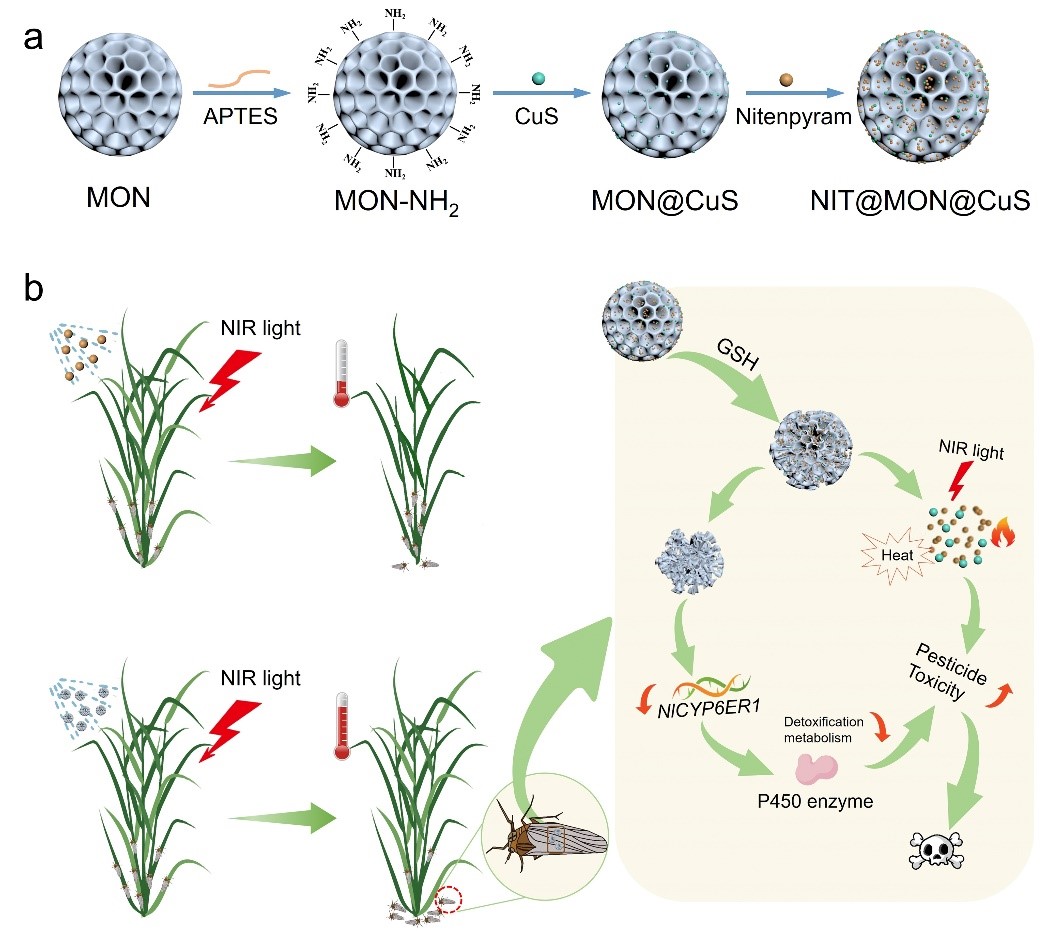南湖新闻网讯(通讯员 宗茂)近日,我校植物科学技术学院农药毒理学及有害生物抗药性团队研究成果以“Redox and Near-Infrared Light-Responsive Nanoplatform for Enhanced Pesticide Delivery and Pest Control in Rice: Construction, Efficacy, and Potential Mechanisms”为题在ACS Applied Materials & Interfaces上发表。研究采用了一种创新的纳米平台,成功实现了对水稻重要害虫褐飞虱防控药剂的高效智能递送,进一步阐明了其增效机制。

纳米平台的合成及其增效机理
褐飞虱(Nilaparvata lugens)是我国水稻生产上的重要害虫,对水稻产量和品质造成严重危害。基于此,研究团队开发了一种镶嵌硫化铜的有机二氧化硅纳米复合载体,将其应用于新烟碱类杀虫剂烯啶虫胺的控制释放。硫化铜纳米颗粒可将近红外光能转化为热量,从而实现农药的快速释放和协同增效效应。同时,有机二氧化硅纳米颗粒具有丰富的孔隙结构和较大的比表面积,可高效负载农药分子,并对害虫体内谷胱甘肽作出响应。硫化铜可实现快速光热转化,纳米平台具有较高的光热转化率,在近红外光的激发下,与烯啶虫胺原药相比,纳米平台对褐飞虱田间种群和抗药性种群的毒力均显著提升。进一步发现纳米平台可显著抑制褐飞虱抗药性种群中P450基因(NlCYP6ER1,NlCYP6AY1,NlCYP4C76)的表达,进而提高其对杀虫剂的敏感性,研究结果为害虫抗药性的治理提供了新思路。该纳米平台在有害生物绿色高效防控方面具有巨大应用潜力。
植物科学技术学院硕士研究生宗茂为论文第一作者,何顺副教授为论文通讯作者,李建洪教授、万虎教授和马康生副教授参与了项目的指导。该研究得到湖北省重点研发计划和国家自然科学基金等项目资助。
审核人:李建洪
【英文摘要】
The brown planthopper (BPH), Nilaparvata lugens (Stål), is a major rice pest in various Asian countries, causing significant negative impacts on rice yield and quality. In this study, we developed a novel nanoplatform (NIT@MON@CuS) for pesticide delivery that responds to redox and near-infrared light stimuli. The nanoplatform consisted of CuS nanoparticles with mesoporous organic silica (MON), loaded with nitenpyram (NIT). With an average size of 190 nm and a loading efficiency of 22%, the NIT@MON@CuS exhibited remarkable thermal response in the near-infrared region, demonstrating excellent photothermal conversion ability and stability. In vitro release kinetics demonstrated that rapid released nitenpyram under near-infrared light and glutathione conditions, facilitating a satisfactory temperature increase and accelerated drug release. The NIT@MON@CuS treated group exhibited a higher mortality of N. lugens, increasing from 62% to 88% compared to the group treated with nitenpyram technical after 96 hours. Bioassay revealed that NIT@MON@CuS significantly enhanced nitenpyram toxicity by more than 1.4-fold against both laboratory insecticide-resistant and field strains of N. lugens. Furthermore, RT-qPCR results demonstrated that MON@CuS had the capability to reduce P450 gene expression thereby improving the sensitivity of N. lugens to insecticides. These findings suggest that MON@CuS hold great potential as an intelligent pest control platform, offering a sustainable and efficient approach to protect crops against pests.
